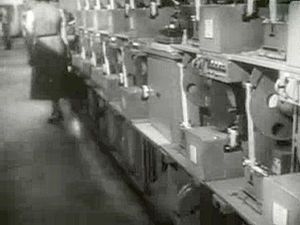
Plan 55-A
Encyclopedia

Store and forward
Store and forward is a telecommunications technique in which information is sent to an intermediate station where it is kept and sent at a later time to the final destination or to another intermediate station. The intermediate station, or node in a networking context, verifies the integrity of...
message switching
Message switching
In telecommunications, message switching was the precursor of packet switching, where messages were routed in their entirety, one hop at a time. It was first introduced by Leonard Kleinrock in 1961. Message switching systems are nowadays mostly implemented over packet-switched or circuit-switched...
system developed by Western Union
Western Union
The Western Union Company is a financial services and communications company based in the United States. Its North American headquarters is in Englewood, Colorado. Up until 2006, Western Union was the best-known U.S...
and used from 1948 to 1976. Western Union's own system handled telegrams, and a military version of the system was used by the U.S. Department of Defense.
Leonard Kleinrock
Leonard Kleinrock
Leonard Kleinrock is an American engineer and computer scientist. A computer science professor at UCLA's Henry Samueli School of Engineering and Applied Science, he made several important contributions to the field of computer networking, in particular to the theoretical side of computer networking...
analyzed the queueing delays of Plan 55-A in his PhD thesis, and this work formed part of the theoretical basis for the ARPAnet
ARPANET
The Advanced Research Projects Agency Network , was the world's first operational packet switching network and the core network of a set that came to compose the global Internet...
.
Plan 55-A was a predecessor of E-mail
E-mail
Electronic mail, commonly known as email or e-mail, is a method of exchanging digital messages from an author to one or more recipients. Modern email operates across the Internet or other computer networks. Some early email systems required that the author and the recipient both be online at the...
. A Plan 55-A center performed functions similar to an e-mail server, but without computers.
In a Plan 55-A switching center, incoming messages came in over serial communication
Serial communication
In telecommunication and computer science, serial communication is the process of sending data one bit at a time, sequentially, over a communication channel or computer bus. This is in contrast to parallel communication, where several bits are sent as a whole, on a link with several parallel channels...
lines from teleprinter
Teleprinter
A teleprinter is a electromechanical typewriter that can be used to communicate typed messages from point to point and point to multipoint over a variety of communication channels that range from a simple electrical connection, such as a pair of wires, to the use of radio and microwave as the...
s or from other switching centers, and were received by "receiving consoles", each consisting of a paper tape punch feeding tape into a paper tape reader via a storage bin. The reader would read the message header, and send the header characters to a "director". The director, much like a telephone switch, would connect the receiving console to a "sending console" in the same switching center. This was referred to as a "cross-office connection". The message would then be transmitted from the receiving console to the sending console, character by character, punching a second paper tape at the sending console. Cross-office connections, and their readers and punches, were slightly faster than external connections, to keep congestion out at the edges of the network.
Each sending console, like each receiving console, consisted of a paper tape punch and reader. Output from each sending console went out on
outgoing lines to other switching centers or to destination teleprinters. Each message typically contained one telegram.

